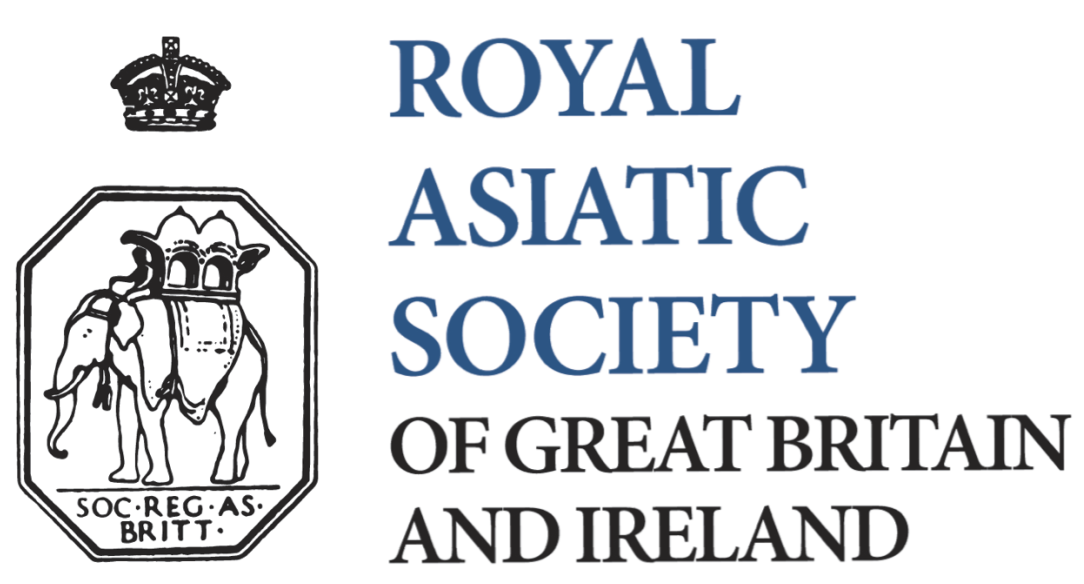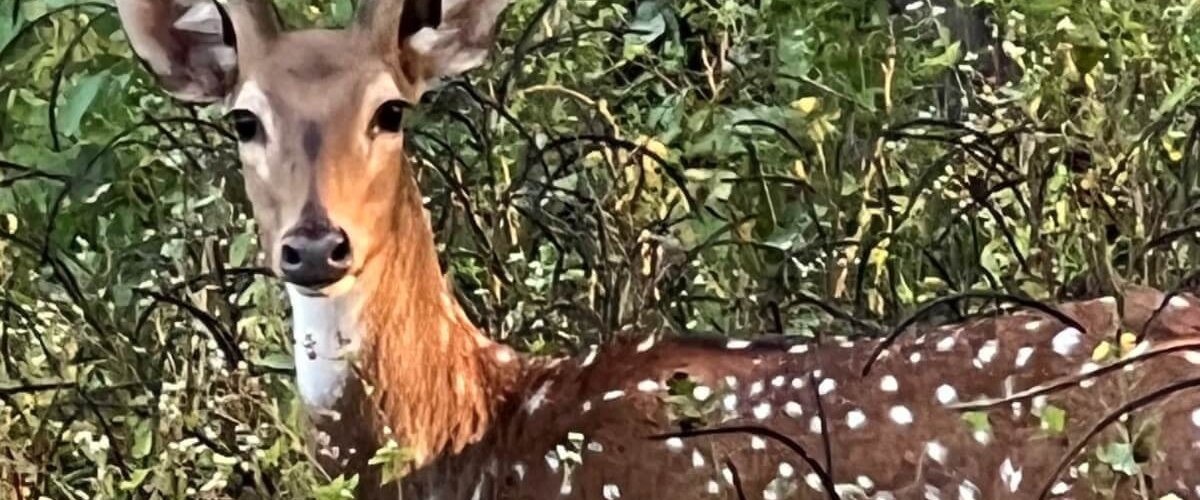Seasons Greetings from the Royal Asiatic Society
The Society would like to send seasons greetings to all of you who read our blogposts with the hope that you will have a good festive season and that 2025 will be a year of joy and opportunity. In our last post for 2024 we return to the Tod Tour. We are very grateful to Dr Alison Ohta for providing these interesting and in-depth insights into their tour.
FAREWELL CAPTAIN TOD
We were now on the last leg of our journey. From Ahmedabad on our way to Bhavnagar we visited the town of Khambhat (Cambay) where Tod went shopping for gifts to take home, as did several members of our party. Tod noted that “it still enjoys celebrity for its agates, mocha stones, cornelians”. The town has small shops selling semi-precious stones and a very imposing clock tower built in 1888.

The mosque in Cambay, which contains the grave of the founder of the mosque, Umar bin Ahmed Kazerooni, who died in 1333, is marked by an elaborately carved tombstone. These tombstones carved in Cambay were exported throughout Asia and described by Elizabeth Lambourne, who wrote her thesis about them, as the ‘must have’ grave memorials for the Indian Ocean elites.

We also visited Lothal, a Harappan port town, c.2500-1900 BCE, with a large dock. The excavations revealed numerous finds of cornelian beads showing the long legacy of stonecutting and polishing in the area.
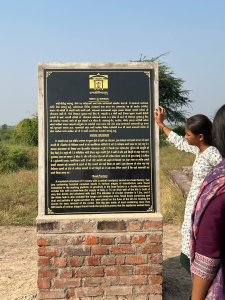
At Bhavnagar, we stayed at the Nilambagh Palace built in 1879 by Maharaja Saheb Takhatsinhji Bhavasingh and in the last blog I described the trip by some of our party to Palitana. Tod had visited the old palace in the town and described “its lofty and roofed towers… shooting up from amidst mango trees.” Today, it is on a very busy road filled with stalls and small shops and is the state bank.
From Bhavnagar, we drove to Sihor, the old capital of the Gohil Rajputs, who moved to Bhavnagar in 1723 as it was easier to defend. Tod tells us that Sihor is of great antiquity and that it was founded in the 10th century. The first king of Sri Lanka is believed to have been born in Sihor and more recently Nana Sahib (1827-1859) who led the siege of Cawnpore during the Rebellion of 1857 hid in Sihor before escaping to Nepal. Today, it is a small town reached by a bumpy road and, on the outskirts, we found the 12th century stepped tank visited by Tod, the Brahma Kund. It had been built by an ancient king who was cured of a skin infection by the water. It is surrounded by 100 idols including a riderless horse with a parasol.
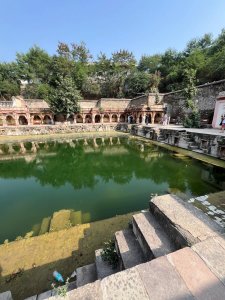
The significance of this site is explained by Liz below:
“Tod visited Sihor on his way from Bhavnagar to Palitana in November 1822. He was aware that “Seehore boasts of great antiquity, and is associated with much of the legendary lore of past days…” He explains that “Its original sanctity arose from a fountain of medicinal virtue, sacred to Gotama, one of the great sages of antiquity, and from the use of such waters, Moolraj (the king of Nehrwalla – modern Patan) was cured of some inveterate disorder, on which occasion he made a grant of Seehore and its lands to the Brahmins.
“He perhaps did not realise quite how ancient Sihor is: it was referred to in the Vedas and it was known as Saraswatpur during the Mahabarata period, when Krishna visited before he went to Dwarka for the rest of his life. It is said that the first king of Sri Lanka, Vijaya the Conqueror, was born in Sihor and exiled. He was believed to have introduced Vedic and Buddhist culture to Lanka. From the 5th-6th centuries, at the time of the Matraika dynasty, Sihor was an important Buddhist centre, as well as Jain.
“We visited the Brahma Kund, a sacred stepped tank with some 100 or so little shrines and statues on the steps. The date of the tank is uncertain but it is mentioned in the 8th century Skanda Purana and is believed to have been re-built in the 12th century by the Chaulukya king Jayasimha Siddhraj, whose skin condition was the result of a curse by the queen he had abducted from Junagadh. The water flowing into the tank is still considered to be holy. The sculptures include a riderless horse with a parasol above it.
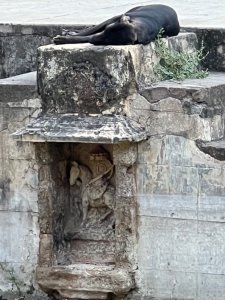
“The significance of the riderless horse is unclear. One interpretation is that in Buddhism, the chatra or parasol stood for the spiritual sovereignty of the Buddha. A parasol was held over him when, as Prince Siddhartha, he rode out from Kapilavastu on his horse Kanthaka in search of enlightenment. In the early aniconic phase of Buddhist sculpture, prior to the 1st century, the Buddha was represented only by symbols, such as a riderless horse with a parasol above an empty space.
“Another explanation may be that the horse represents the Ashvamedha Yagya, or horse sacrifice, a ritual dating back to the Vedas used by ancient kings to assert their imperial sovereignty and ensure the prosperity of the kingdom. After elaborate ritual preparations, a riderless horse was set free to roam for one year, accompanied by courtiers and warriors. The parasol and the halo below it indicate that the horse belonged to the king. It also had a mark on its forehead and was caparisoned. The duty of the warriors was to protect the horse and return it to the kingdom at the end of the year. It was then sacrificed in a complex ritual lasting 27 days and culminating in the chief queen sleeping beside the dead horse in a position mimicking sexual intercourse.
“The ritual is described in the fourteenth book of the Mahabarata, the Ashvamedhika Parva, in which Krishna and Vyasa advise King Yudhishthira to perform a horse sacrifice. In this version, the horse is followed by Arjuna with an army whose task is to challenge anyone who objects to the free movement of the horse. At the end of the year, the victorious Arjuna, who has risked death and is only saved by his wife’s use of a mystical gem, returns and Yudhishthira is established as the emperor and is recognised by the rulers of other kingdoms. The horse is about to be sacrificed when a blue- eyed mongoose appears and declares that this animal sacrifice is not equal to the gift of a tiny amount of barley by an ascetic. The priests ask if animal sacrifice is appropriate or whether a handful of barley should be substituted and the animals set free. The king suggests that large gifts from a sinful person are of no value, but even a small gift from a righteous person given with love is of great merit.
“Given that Brahminism, Jainism and Buddhism seem to have co-existed for several centuries at Sihor, either explanation seems possible. In some societies, including our own, a riderless horse symbolises death, for example, at Mountbatten’s funeral his 22 year old horse, Dolly, was led at the head of the gun carriage with Mountbatten’s boots reversed in the stirrups. At Queen Elizabeth’s funeral procession her black fell pony, Emma, was saddled but riderless.”
Liz Driver
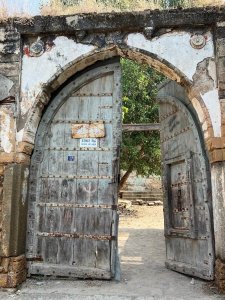
We then continued to the town to see the former royal palace, the Darbargardh of the Gohil Rajputs between 1570-1723.

This elaborately carved wooden house with three storeys is set in a small courtyard with flower beds and is well cared for by the custodians. The palace has some remarkable murals painted by Kamangai of Kutch. The rooms are for the most part now inhabited by bats but the paintings on the upper floors are in remarkable condition. The night before at the hotel in Bhavnagar we saw cards on which the wall paintings had been reproduced.


The Black Buck sanctuary, part of the Velavadar National Park, owned by the Bhavnagar royal family, was the next stop on our journey. It provided another interesting aspect to our travels looking at the wildlife of the area: nilgai, jackals, wolves and wild boar. We went on a late afternoon game drive across the flat grass land and saw several black buck, the second largest of the antelope family and the fastest long distance runner of all animals. As we returned to the hotels the skies were filled with harriers returning home after scavenging in the nearby towns. Apparently the park has the largest harrier roost in the world.

From the Black Buck sanctuary, we continued to the Sasan Gir Wildlife Park. This is much larger than Velavadar and was formerly the Nawab of Junagardh’s private hunting area and established as a wildlife sanctuary by the Nawab in 1965.

It contains 674 Asiatic lions, as well as panthers, leopards, hyenas and foxes. The early morning rides provided great excitement viewing lions and leopards at close quarters.
The next day we visited the Jain temples at Girnar which have been an important religious site for over 2,000 years. Tod was carried in a ‘celestial chair’ to the first group of temples. These are still available today but there is also now a ropeway to aid the ascent.

This was followed by a visit to the Uparkot Fort, built c.300-200 BCE and rebuilt many times since. It has a 15th century mosque and three large cannon manufactured in Cairo and brought by a Turkish flotilla who came to assist Sultan Bahadur Shah against the Portuguese. They were defeated and left the guns behind. When Tod visited the fort, it was overgrown and he maintained he was the first European who was allowed to visit. He commented that no Hindu buildings remained and that the mosque was built using what was left of them.
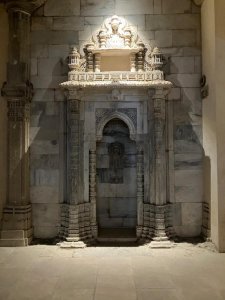
Within the fort are three Buddhist caves dating from the 1st century as well as two other complexes of caves. Also preserved are Ashoka rock edicts in Brahmi script. Tod was not sure what these were when he saw them and copied the inscriptions. (James Prinsep deciphered the Brahmi script and published his findings in the Journal of the Royal Asiatic Society.)
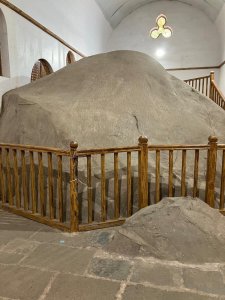
We spent the following day at Diu, a small island which is joined to the mainland by two bridges but is not part of the State of Gujarat. It was Portuguese territory until 1961 and is now administered as the union territory of Dadra, Nagar Haveli, Daman and Diu. The first contact between Portugal and India occurred when Vasco da Gama landed at Calicut on the Malabar coast in May 1498. The Battle of Diu took place in 1509 when a fleet of 18 Portuguese ships defeated the forces of the Gujarat Sultanate, the Sultan of Zamorin (from Kerala) and their Egyptian Mamluk allies. Later in the 16th century, the Sultan sought help from the Portuguese when the Mughal Emperor Humayun was preparing to attack Gujarat to annex the Sultan’s territory. The Portuguese were then able to occupy Diu and build a fort. Tod makes his views clear on the Portuguese describing their acts of piracy and the murder of the Emperor of Gujarat while “professing a religion which inculcates as a primary duty ‘Thou shalt love thy neighbour as thyself'”. The fort has two moats, a lighthouse, a chapel, a church and bastions!
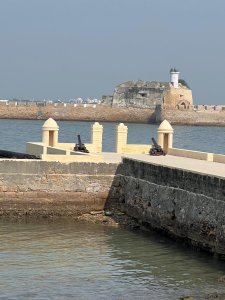

We had a lovely lunch in Diu but no alcohol for,despite its reputation as a place where the Gujaratis come to drink, the restaurant did not serve wine!
The next day we left the Postcard Hotel which had been wonderful and travelled to Junagadh. Liz told us a very amusing story which very much deserves repeating:
The Nawab Muhammad Mahabat Kahanji was passionately fond of dogs and is reputed to have owned 3000, who lived in elaborate kennels each with its own bath, bed, serving table attendant and telephone. They travelled in palanquins and the favourites had diamond studded collars. On the wedding of his favourite bitch Roshana to a handsome golden retriever called Bobby which cost 30,000 rupees, The Viceroy, Lord Irwin, was invited but declined to attend. The Nawab’s chief minister was Shah Nawaz Bhutto, the father of Pakistan’s future prime minister. At Partition the Nawab was advised to join Pakistan, a decision which defied the wishes of the people. Junagadh was surrounded on three sides by Indian territory with its main port 325 nautical miles from Karachi and with 80% of the population being Hindu. Pakistan officially recognised the accession but with the declaration of independence from Junagadh by the tiny state of Barbariawad and its accession to India, Junagadh was subsequently annexed to India. However, Pakistan has never recognised Junagadh as part of India and as recently as 2021, a map of Pakistan included Junagadh.
The Nawab and his family fled to Pakistan. He took his wives, 24 children and 8 of his Pekinese to the airport but as the flight was about to depart for Karachi one of his wives remembered she had left a daughter at the palace and went back to fetch her. The Nawab did not wait and loaded 2 more dogs on to the plane and took off.
A visit to the old palace and its museum revealed a portrait of the Nawab and, as you might guess, his favourite dog.

The tombs of the Nawab in the town are equally interesting. Built in the late 19th century in an Indo-Saracenic style with European influences, one of them is provided with 4 minarets with a staircase running around the outside. The Friday Mosque is built in the same style.
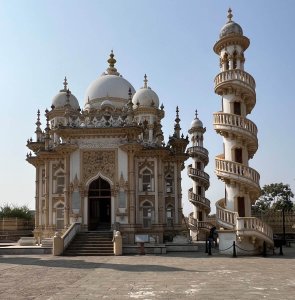
We said our farewells to Tod at Junagadh as he headed northwest, leaving from Mandavie for Bombay to catch the Sarah, bound for England. We travelled to Gondal preparing to fly back to Mumbai from Rajkot. Maharaja Bhagwant Singhji of Gondal, who reigned between 1888 until 1944, was noted for his tax reforms and the compulsory education for women. He was a man of many talents – a lawyer, doctor, ornithologist to name but a few. We visited the Naulakha Palace erected in 1748 CE which is now a museum and we discovered a link with the Royal Asiatic Society listed among his many accomplishments.

Tod was a wonderful companion on this journey but Liz Driver, who worked so hard on the fabulous itinerary, really brought the tour alive for us with her anecdotes and copious research and, above all, her knowledge of Tod. All of us who travelled with Tod and Liz can only thank her so very much for giving us these very unique and special memories.
Alison Aplin Ohta, 17 December 2024
